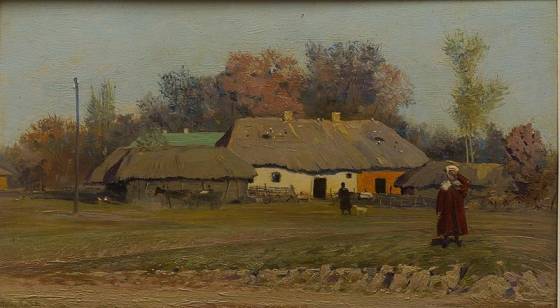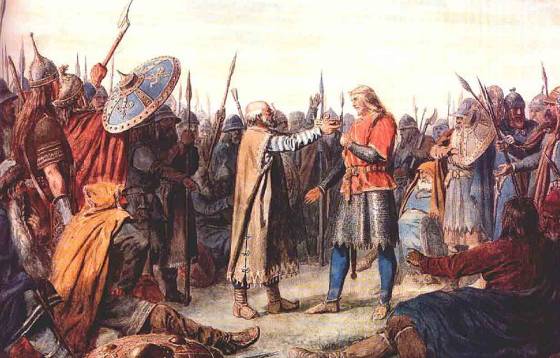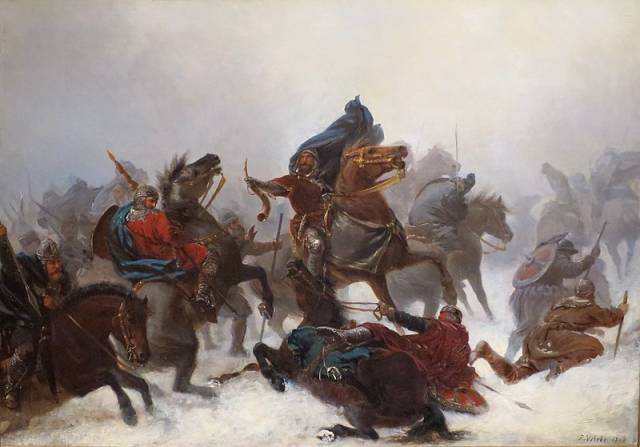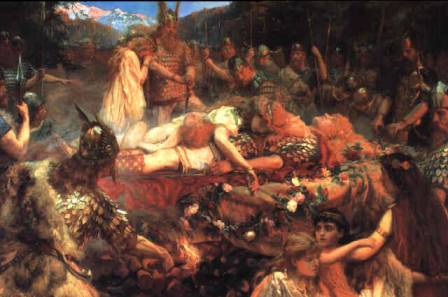Ireland before the Vikings
Before the Viking invasion of Ireland began, 8th-century Irish culture and politics were homogeneously Gaelic. The Irish people tended to live in largely rural communities, with the largest settlements being around monasteries. These monastic towns were where wealth was concentrated and would prove to be tempting targets for Viking raids in the late 8th and early 9th centuries.
Politically, Ireland was dominated by a single, major clan: the Uí Neílls. The family dominated the northwestern and central eastern parts of Ireland, with the northern branch dominating much of the modern counties of Donegal, Fermanagh, Tyrone, Derry, Monaghan, and Cavan, while the southern branch controlled vast portions of the modern counties Meath, Westmeath and Offaly, and was considered to be High Kings of Ireland.
The kingdoms of Connachta (Connaught,) Laigin (Leinster,) and Mumu (Munster,) were ruled independently, but were of lesser importance, politically, compared to the Uí Neíll.
Ireland was unprepared and a tempting target
Militarily, Ireland also presented a tempting target for the Vikings. The widely dispersed population, isolated monastic towns, and lack of standing armies meant that plunder could be easily taken without the worry of concentrated resistance.

This lack of military preparedness for naval raiding made sense in the context of Irish warfare at the time; the primary form of major conflict for Ireland at the time was the cattle raid, and the raiders would be reliant on speed rather than heavy armour. As such the Irish were unprepared to resist heavily armed Viking raiders when they came in their ships and were forced to quickly adapt to the threat.
Despite this, the Irish did put up a determined and continued resistance to the Viking invaders and colonizers. The impact of the Vikings, however, was massive and has lasted to the present day, with cities like Cork, Waterford, Limerick, and Dublin all owing their existence to Viking efforts at urbanization and settlement.
The First Viking Age in Ireland
Note: Unless otherwise noted, all dates are taken from the Annals of Ulster, the Annals of the Four Masters, and the Annals of Inisfallen
The first recorded Viking raid in Ireland was in 795 when the monastery on Lambay was looted. In 798 and 807, more raids – mainly along the coasts of Brega and Connachta occurred.
The Vikings pillaged their way around the monastic centres outside of the Uí Neíll territories with seemingly little in the way of resistance. The Vikings had an early, long-lasting effect on Irish culture at this point.
In 814, a new monastery at Kells was consecrated, as a way of protecting both the monks and the relics of St. Columba from marauding Vikings. This monastery, located well inland, would eventually become the home of the Book of Kells. It is one of the finest and most extravagant examples of illuminated Insular-style manuscripts.
The war between Mumu and the Uí Neíll
Despite the raids on other kingdoms, the Uí Neíll territories remained relatively peaceful, which allowed for the expansion of their power in the north and caused concern for other kings. The king of Mumu, Feidlimid mac Crimthainn, began aggressively countering the High King’s expansion.
The war between the two kings lasted from 820 until 827. It came to an end when the Uí Neílls were brought to a peace conference by Feidlimid.
This weakening of the High King’s power was made even more evident by the fact that, in 833, High King Niall Caille was forced to lead an army against Viking raiders who had made themselves a base in Derry. He routed them, but that same year the monastery at Clondalkin, near modern Dublin, was sacked.
The Vikings establish longphorts
The attack at Clondalkin was an important development in the history of Viking age Ireland. Since 821, Viking attacks had begun to intensify and the raiders began establishing longphorts, or naval bases, along rivers and coastlines.
The first two known longphorts were at modern Annagassan and Dublin (Ó Corráin, p. 19,). This allowed raids along the north and south coasts of Ireland but, more importantly, allowed access to territories further inland. The riverine raids launched by the Vikings from these longphorts became larger and larger.
Describing these attacks there are reports of fleets of 60 ships or larger being made in the annals. In 837, two such fleets attacked along the rivers Boyne and Lifey and plundered all along the rivers and into the kingdom of Brega.
These fleets, with nearly 3000 men between them, were led by a man named Thorgest (possibly Þorgísl or Þurgestr in Old Norse, also Turgéis in Irish and Turgestis in Latin). They were responsible for the sacking of the fishing community of Dublin. The longphort he built on the Lifey would eventually form the basis of the modern city of Dublin. Later it would also serve as the base from which raids against the monastic towns of Armagh, Glendalough, and Clonmacnoise, among others, were launched.
The arrival of new Viking leaders change the luck of the Irish
Thorgest ruled in Dublin until his death in 845. At that time he was defeated in battle by the king of Mide and drowned in Lough Owel. For the next few years, the Viking occupation appeared to be on the back foot. The Irish won a number of battles in 848 that encouraged them to send a report of their victories to Charles the Bald, the Emperor of the Franks.
In 853, however, the situation changed for the Irish with the arrival of two new Viking leaders. They were Amlaíb and Ímar, better known as Óláfr inn hvíti and Ívarr Hinn Beinlausi, the son of Ragnar loðbrókr, and brother of the Viking leaders in England.
The two Viking leaders would quickly begin expanding their influence in Ireland, allying themselves with varying kings against common enemies. In 858 they allied themselves with the king of Osraige, the small kingdom between Mumu and Laigin, against his larger neighbours, and raided Mide, the small kingdom to the north of Laigin.
Not only did it allow Óláfr and Ívarr access to more plunder and the ability to keep their warriors well trained, but it had the added benefit of allowing the Viking leadership to expand their own territory near Dublin, which was located on the border between Laigin and Mide.
Dublin as a seat of power for the Vikings
The Viking settlement in Dublin would serve as a commercial and political hub for the Norse in Ireland. From Dublin, they continued to shift their alliances to whichever Irish king would allow them to expand and consolidate their influence.
Ívarr and Óláfr continued to rule the Viking community in Ireland until their deaths (or, for Óláfr, his disappearance.) In 871, both Viking rulers were reported as having returned to Dublin from a trip to Alba. They had a fleet of 200 ships and, according to the Three Fragments of Annals, brought with them “a great number of prisoners, both British, Scottish, and Saxon.”
This is the last time Óláfr appears in history. It is possible that he is identified with Óláfr Gúðrøðsson, king of Vestfold in Norway, in the Three Fragments of Annals. It is not clear, however, if it is the same Amlaíb/Óláfr that is referred to in other entries, or simply that another Viking by the name of Óláfr returned to Norway to assist his father in winning the kingdom of Vestfold.
In 873, Ívarr died and his passing was noted thus in the Annals of Ulster:
Imhar, rex Nordmannorum totius Hibernie & Brittanie, uitam finiui.
Ívarr, the king of all Northmen in Ireland and Britain, ended his life.
As king of Viking Dublin and ruler of the Vikings in Ireland and Britain, Ívarr’s power and prestige would have been great, and his throne a coveted possession. His descendants – the Uí Ímair – would become influential figures in Viking and Irish history, and play important roles in determining Irish history. Unfortunately for his immediate children, their lives would not be as glorious as their father’s.
Ívar’s sons as kings of Dublin
Ívar’s first son, Bárðr, or Bárid, took the throne of Dublin after his father’s death and ruled it until his own death in 881. During his reign, Bárðr and his cousin Eysteinn launched successful raids and attacks on Irish territory.

They also fought off an attempted overthrow by Halfdan, Ívars brother, in 875. In 877, Halfdan attempted to overthrow Bárðr again and was killed in this second effort, with Bárðr leading an army of “finngaill,” or fair foreigners.
The battle was not without its costs for Bárðr, though: According to the Cogad Gáedel re Gallaib, a 12th-century account of the battles between the assimilated Hiberno-Norsemen and newly arrived Norsemen, Bárðr was severely wounded and left permanently disabled. The last mention of Bárðr is in 881, when he died, apparently as the result of a miracle by St. Ciannán.
After Bárðrs death, his brother Sigfrøðr, or Sichfrith, became king of Dublin. While he reigned longer than his brother, it did not appear that he was particularly notable in Irish history, apart from a single major victory over the Irish in 888. That same year, Sigfrøðr was “deceitfully killed” by a kinsman of his, though no specific details are given.
Ívars last son, Sigtryggr, or Sitruic, ruled for another 8 years, and his reign seems to have been extremely contentious.
The end of the first Viking age
In 893, the Vikings in Dublin split their allegiance between Sigtryggr and a jarl named Sigfriðr. This division spoke to the waning political power and stability of the Ívar’s dynasty in Dublin and it appears as though Sigtryggr was forced to leave Ireland in that same year, as the Annals of Ulster report that he returned in 894.
There appears to have been an attempt by Sigtryggr to reinforce his rule with a major raid in 895. However, it did not succeed, as Sigtryggr was killed “by other Norsemen” in 896.
The last Viking king of Dublin was Ímar ua Ímair, Ivar II, the grandson of Ívarr, though he ruled for only 6 years. In 902, a combined force of Irish from Brega and Laigin drove the Vikings from Dublin and forced them to retreat to Scotland, effectively ending Viking rule in Dublin for the next 15 years.
The Second Viking Age in Ireland
In 914, the Vikings returned to Ireland. A fleet arrived in Waterford Harbour and resumed harrying the Irish over the next three years. In early 917, two of the Uí Ímair – Ragnall mac Bárid ua Ímair and Sitric Cáech – commanded the Viking forces. After several bloody battles, Ragnall established himself in Mumu, near modern Waterford.
Sitric sailed on for Laigin, near the modern town of Leixlip. In the south, Ragnall found himself relatively unopposed, and Sitric found much the same situation in the north. By August of 917, though, the Irish had mustered enough strength to make a concentrated assault on the Viking forces.
In Mumu, High King Niall led an army to attack Ragnall and met him in battle on the 22nd of August. The fighting was long and bloody and, at first, the Irish had the upper hand. The hundred or so initial casualties, the Annals of Ulster report, were mostly Vikings.

However, as the battle drew on, the Viking strategy became apparent. The Irish had been exhausted by their battle and the Viking army had a large force in reserve. The assault by Ragnall and his reinforcements caused the Irish army to retreat to their camp. There they held their positions while High King Niall sent word to the men of Laigin to attack Sitric and draw off some of Ragnalls force.
This did not go as planned for the Irish.
Battle of Cenn Fuait
Sitric and the men of Laigin met in the battle of Cenn Fuait, and the Irish had horrible losses. The Irish army suffered over 500 casualties, and, according to the Annals of Ulster,
…there fell too Ugaire son of Ailill, king of Laigin, Mael Mórda son of Muirecán, king of eastern Life, Mael Maedóc son of Diarmait, a scholar and bishop of Laigin, Ugrán son of Cennéitig, king of Laíges, and other leaders and nobles.
The utter defeat of the Irish and the death of so many of their leading men allowed the Viking forces under Sitric to advance, unopposed, into Dublin and re-establish a Viking kingship in the city. Meanwhile, Ragnall and his men were bolstered by the arrival of his reinforcements. Maintaining the pressure on High King Niall, he was eventually forced into retreat, securing the Viking position in Mumu.
Viking dominance in Ireland
The next few years saw much fighting between the Irish and Viking kings, and almost all of it favoured the Vikings. In 918, Ragnall took a number of men to Scotland and waged war there, quite successfully, before returning to Ireland.
The next year, in 919, Sitric inflicted possibly the most important defeat of his life on the Irish. In mid-October, High King Niall attacked Dublin, trying to dislodge the Vikings from their positions there, and was thoroughly defeated by Sitric’s army. The Annals of Ulster, again, list the losses for the Irish in this absolute disaster:
[there] fell Niall Glúndub son of Aed, king of Ireland, in the third year of his reign, on the fourth feria, the eighteenth of the Kalends of October 14 Sept., and here fell also Aed son of Eochucán, king of Conchobor’s Province, and Mael Mithig son of Flannacán, king of Brega, and Conchobor grandson of Mael Sechnaill, heir designate or king of Temair, and Flaithbertach son of Domnall, heir designate of the North, and the son of Dub Sínaig, i.e. Mael Craibe, king of Airgialla, and many other nobles.—The battle of Áth Cliath [Dublin] won by the foreigners.
So many Irish nobles were killed at this battle that the Vikings were able to rule almost unopposed until 927. During this time, other Viking settlements in the south – Limerick, Cork, and Waterford – gained power as well, and Ragnals power was so secure that he left for York to become king there. In 920, Sitric left to join Ragnall in York and succeeded him as king in 921.
The Vikings became assimilated into Irish culture and values
Gothfrith became king of Dublin after Sitric, and his reign marked a change in the way that the Vikings acted toward the Irish. During an attack on the monastic town of Ard Macha in 921, the Vikings did their best to avoid damaging the religious buildings. As the Annals of Ulster relates:
Ard Macha was invaded by the foreigners of Áth Cliath [Dublin], i.e. by Gothfrith grandson of Ímar, with his army, on the fourth of the Ides 10th of November, the Saturday before the feast of Martin, and the prayer-houses with their complement of culdees and sick he spared from destruction, and also the monastery, save for a few dwellings which were burned through carelessness. They harried widely on all sides, westwards to Inis Ua Labrada, eastwards to the Banna, and northwards to Mag Ilesen.
Leaving the priests, prayer-houses, monastery, and sick in peace marks a shift from the usual Viking tactics, where laying waste to everything they could was de rigueur. For the Christian Irish, however, religious sites were off limits, generally speaking. The Viking’s refusal to damage them in 921 suggests that they were becoming more assimilated into Irish culture.
In 927, Sithric died and Gothfrith left Dublin for York, claiming the crown as his own. He was driven out by Athelstan, though, and returned to Ireland six months after he left. On his return, he found that Dublin had been conquered – although not by the Irish, but by other Vikings, from Limerick. Gothfrith drove them out, and resumed his rule, but remained in conflict with Limerick until his death in 934.
The next thirty years saw Limerick become more powerful than Dublin and the Vikings, in general, become more intertwined with the Irish, allying with various kings to expand their political influence in Ireland.
The end of the Viking age in Ireland
968 marked the beginning of the end of the Viking age in Ireland. The Dalcassians, under Brian Boru, attacked Limerick. The Irish devastated the Viking army at the battle of Sulcoit and pursued them back to their fortress at Limerick. There they defeated the routed Viking army and burnt the fortress to the ground. The remaining Vikings spread throughout Mumu as the Dalcassians continued their attacks over the next decade.
In 976 (or 977, depending on whether one is reading the Annals of the Four Masters or the Annals of Inisfallen, respectively) the Dalcassians destroyed the last of the Limerick Vikings at the battle of Cathair Cuan, killing the last Viking king of Mumu, Harald Ivarsson.
Two years later, at the battle of Tara, Brian Boru led the Dalcassians in another successful battle against the Vikings of Dublin and defeated them so soundly that Óláfr Sigtrygsson, the king of Dublin, abdicated his throne and retired to monastic life.
As the 10th century came to a close, the Vikings in Ireland were put on the back foot, losing battle after battle against the Irish. In 999, Sigtrygg Silkiskeggi (Siggtryg Silkbeard) declared himself king of Dublin and, along with the kingdom of Laigin, rose in rebellion against Mumu and the Irish High King.

The rebel kingdoms were put down by a combined force of Irish led by Brian Boru – now king of Mumu – and Máel Sechnaill mac Domnaill of Meath. The defeat was so crushing that Boru was able to lead his army straight to Dublin and occupy it. This gave him a massive amount of power in Ireland, and he consolidated his position by taking Tara and declaring himself the High King of Ireland.
The Battle of Clontarf
The final nail in the coffin for the Vikings in Ireland was in 1014, at the battle of Clontarf. Brian Boru’s High Kingship was not uncontested, and the kingdoms of Dublin and Laigin both rose up against him. They called on Vikings from both the Earldom of the Orkneys and the Kingdom of the Isles. The Vikings joined the rebels and, on 23 April, met the Irish at Clontarf, Dublin.
The battle lasted from first light to last, and saw some of the fiercest, most bloody fighting in Ireland, according to the Cogad Gáedel re Gallaib. The Viking forces served as heavy infantry, being the only fighters on the field wearing mail armour. However the Irish forces outnumbered them considerably and, as the battle wore on, their numerical superiority began to show.
Eventually, the Vikings and their allies broke, and fled to their ships, retreating from Ireland. Thus ended the Vikings’ political and military exploits in Ireland.

Fascinating and valuable supplement to my other reading on the subject. I was particularly interested in the comment that after being defeated by the Dalcassians under Brian Boru, the remaining Vikings dispersed throughout Mumu. That could explain how my family from north Kerry ended up as 2% Viking, according to Ancestry DNA.
Thanks for your kind comment and for sharing some fascinating insight into your own ancestry Richard!
Excellent overview-many thanks.
Thank you Tanya, great that you liked it!